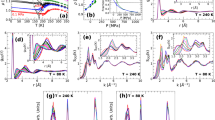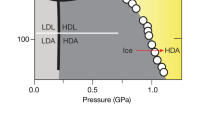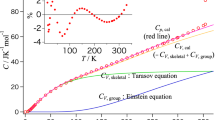Abstract
THE configurational entropies of amorphous solids reflect certain aspects of their structures, in particular the numbers of accessible molecular configurations. The configurational entropy of vitreous silica has been estimated theoretically1 as no more than 5.8 J K−1 mol−1, which agrees reasonably with experiment. That of low-density amorphous ice has been estimated theoretically2 as ∼6.3 J K−1 mol−1 more than that of ice Ih, using a model that assumes a continuous random network of hydrogen bonds. This value corresponds to ∼ 2.1 more configurations per molecule than in ice Ih, and seems consistent with the result for vitreous silica1. In principle, these entropies can be obtained from the change of heat capacity from the glass to the liquid and the entropy of freezing of the liquid at equilibrium, but such measurements have not proved possible because the liquid generally crystallizes too quickly. Here we show that the entropies can be estimated approxi-mately by another method: from the thermodynamics of the transformations of, for example, both ice Ih3 and low-density amorphous ice4 to high-density amorphous ice. The entropy of high-density amorphous ice relative to that of ice Ih is estimated as 2± 1 J K−1 mol−1 and that of high-density relative to low-density amorphous ice is estimated as 1 ±0.5 J K−1 mol−1. The entropy of low-density amorphous ice relative to ice Ih is therefore ∼ 1 J K−1 mol−1. The earlier estimates2,5 of this quantity are there-fore several times too high. These low values limit the amount of disorder that can be present in the amorphous phases.
This is a preview of subscription content, access via your institution
Access options
Subscribe to this journal
Receive 51 print issues and online access
$199.00 per year
only $3.90 per issue
Buy this article
- Purchase on Springer Link
- Instant access to full article PDF
Prices may be subject to local taxes which are calculated during checkout
Similar content being viewed by others
References
Bell, R. J. & Dean, P. Phys. Chem. Glasses 9, 125–127 (1968); 10, 164B (1969).
Sceats, M. G. & Rice, S. A. J. chem. Phys. 72, 3260–3262 (1980).
Mishima, O., Calvert, L. D. & Whalley, E. Nature 310, 393–395 (1984).
Mishima, O., Calvert, L. D. & Whalley, E. Nature 314, 76–78 (1985).
Johari, G. P. Phil. Mag. 35, 1077–1090 (1977).
Handa, Y. P., Mishima, O. & Whalley, E. J. chem. Phys. 84, 2766–2770 (1986).
Klug, D. D., Mishima, O. & Whalley, E. J. chem. Phys. 86, 5323–5328 (1987).
Floriano, M. A., Handa, Y. P., Klug, D. D. & Whalley, E. J. chem. Phys. (in the press).
Bridgman, P. W. Proc. Am. Acad. Arts Sci. 47, 441–558 (1911).
Klug, D. D. & Handa, Y. P. J. phys. Chem. 92, 3323–3325 (1988).
Hemley, R. J., Chen, L. C. & Mao, H. K. Nature 338, 638–640 (1989).
Kuriakose, A. K. & Whalley, E. J. chem. Phys. 48, 2025–2031 (1988).
Author information
Authors and Affiliations
Rights and permissions
About this article
Cite this article
Whalley, E., Klug, D. & Handa, Y. Entropy of amorphous ice. Nature 342, 782–783 (1989). https://doi.org/10.1038/342782a0
Received:
Accepted:
Issue Date:
DOI: https://doi.org/10.1038/342782a0
This article is cited by
-
Melt-quenched glass formation of a family of metal-carboxylate frameworks
Nature Communications (2024)
-
Experimental tests for a liquid-liquid critical point in water
Science China Physics, Mechanics & Astronomy (2020)
-
A twist in the tale of the structure of ice
Nature (2019)
-
Annealed high-density amorphous ice under pressure
Nature Physics (2006)
-
The mechanisms for pressure-induced amorphization of ice Ih
Nature (1999)
Comments
By submitting a comment you agree to abide by our Terms and Community Guidelines. If you find something abusive or that does not comply with our terms or guidelines please flag it as inappropriate.



